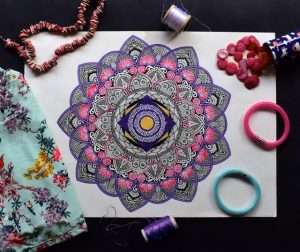Facts about art: the post about painting that you have been waiting for.
Artists have used color to create different moods and feelings, a way to convey meaning through visual representation. Color is an important element in art.
Color creates a mood just as it does in life. When a person feels sad they may want to wear darker colors like black or gray, while someone who is feeling happy may choose lighter colors like yellow or green.
The way people feel about their lives can be depicted by the color schemes of their paintings. If a person’s painting contains many bright and cheerful colors, then the artist probably was in good spirits when he painted it. The more somber colors like red show how an artist may feel during hard times such as war or illness.
Color is important to artists because it creates emotion and mood within the viewer of a painting. It is also very important in everyday life because emotions are transmitted through color choices everyday just as they are in art.
Art is not just a form of expression or a medium to express feelings; it is the reflection of the society that made it. The origin of art can be traced back to the Stone Age cave paintings found in Europe, Africa and Asia. These ancient cave paintings clearly show that art is not just for aesthetic pleasure, but also has a number of other purposes like healing and religious rituals. The first forms of art are paintings, sculptures and drawings. People back then used these forms of art as an expression of their feelings. In time more and more forms of art have emerged based on different eras and cultures.
The history of art dates back to 6,000 BC in the Neolithic age, which is the beginning era of human civilization and one can find examples of art in almost every form imaginable. Art today has evolved into a very broad field with a wide range of mediums to choose from such as painting, sculpture, graphic design, etc., but still holds true to its origins as an expression of feelings and emotions from the artist. Art continues to evolve day by day and will continue to do so because it will always be representative of its era or culture.
Art has been around for thousands of years. It started with cave paintings and has evolved into films, plays, music, and much more. In fact, there are many different kinds of art. There is fine art such as paintings, sculptures, and drawings. There is popular art such as songs, comics, and holiday decorations.
Art is also a form of communication. Art can express emotions or ideas. It can be used to make a statement about politics or the environment or just how you feel on a particular day. Art can take people out of their normal lives and transport them to another place or time.
Art gives its audience the opportunity to be creative in their minds through interpretation of a work of art. Some pieces of art have multiple meanings that can be interpreted by different people in different ways. Music is another example of an art form that creates moods and feelings for listeners. A sad song may cause one person to think about lost love while another person may think about a memory of a loved one who has passed away.
Art is a broad term. It defines any creative work that is expressed in a tangible medium. This includes music, visual art, drama, and literature. In the context of this blog, we will examine art as it relates to visual art.
The unity in art refers to the use of one central idea or unifying symbol. Every painting must have a unifying symbol or idea that ties all of the elements together into one composition. The artist creates a balance between dramatic and restful areas using color and shape. A painting can be divided into two major areas: the foreground and background. The foreground is the part of the painting closest to the viewer while the background is farthest away from the viewer.*
The purpose of the unity in art may be to show different aspects of an object or series of events simultaneously. This allows for an increased feeling of depth which makes for more interesting paintings.*
Artists try to create feelings and emotions through their paintings by using shapes, colors, symbols, and textures.*
An artist’s style may be defined by his use of line, color, shape and texture as well as his use of space.*
Art is an ancient human activity and artists have always been inspired by previous artists or eras. However, there is a difference between copying an artist’s work and being inspired by their work. The former is straight up plagiarism, but the latter often results in great art.
Listed below are three famous examples of art that have been copied and one example of art that has been inspired from another piece of art.
The unity in art is a main element of aesthetic experience. The unity in art is what gives the art a sense of being complete. For example, a painting that carries out a picture plan will have a unified structure. It will have a beginning, middle and end. It will have a central theme. If it does not have these three elements, the painting fails to carry out its task as an artwork.
The unity in art has been discussed by many theorists from Aristotle to Kant and Hegel. They all agree that the unity in art is one of the essential elements of beauty and aesthetic experience.
If you remove the unity from the artwork you destroy its aesthetic value. The work no longer fulfills its purpose as an artwork; it does not produce an aesthetic experience for the viewer/listener/reader etc…
A lot of artists try to break with tradition, or create something new or shocking. This is fine as long as it’s done in the name of self-expression and not to shock people or get attention. People can be shocked by things such as nudity or violence without understanding why they are shocked, just because they are told to be shocked.”
Unity in art is the ability of a piece of artwork to be one, having a single purpose. The word Unity actually means “connecting or bringing together” and it is not just for art but for life as well.
Artwork is usually judged by its unity, meaning that if it doesn’t have unity then it can’t be considered a masterpiece.
In literature, the work is usually unified by the main idea or theme i.e. some sort of message that the author wants to convey to readers. A good example of this is J.R.R Tolkien’s The Hobbit which has a unifying theme – “Home is behind, the world ahead”.


